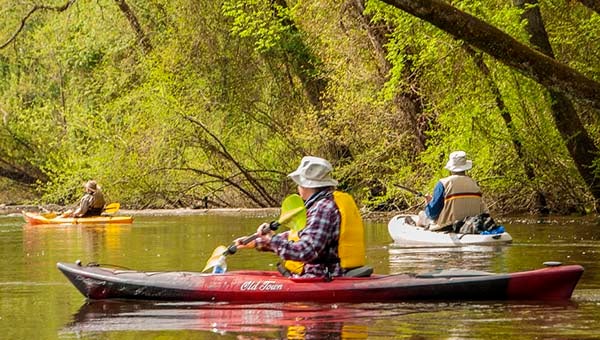Master Naturalists do more than walk in the woods
Published 11:14 am Saturday, January 25, 2014

Field trips are an essential part of learning to become a Master Naturalist, as well as conducting experiments and conservancy. Shown are kayakers Toni Nolf, owner of Blackwater Outfitters and one of the guides, along with members Lynn Thornton and Keith Jordan. — SUBMITTED | CAROL EVANS
ISLE OF WIGHT—People who love nature and want to take that passion to a higher level are invited to become Master Naturalists. They can start on Tuesday by attending an informal introduction of the Historic Southside Chapter – Virginia Master Naturalist.
Know first that becoming a Master Naturalist involves more than just walks in forests or taking photos. This is for people who are serious about learning, volunteering and conserving.
First, those interested and accepted into the program will have classroom training lasting from 6:30 to 9:30 p.m. Tuesdays for about 10 weeks starting Feb. 4. Master Naturalists, Isle of Wight Extension staff and area specialists will be the teachers. The $100 fee covers costs and materials for the classes and field trips; there’s no additional charge for the instruction.
Subjects include ecology, botany, wetlands, geology, forestry, birds, mammals, climate and weather. There will be an exam and project. There will be visits to the Great Dismal Swamp, Blackwater River, Chippokes Plantation and the Piney Grove Nature Conservancy in Waverly.
As mentioned, the chapter members are active in conservation. For example, they are concerned about Microstegium vimineum, better known as Japanese stiltgrass. This invasive weed can take over areas, said Janet Spencer, agent for the IOW Extension Service, which is one of the sponsoring agencies of the chapter. She’ll also be teaching a couple of the classes.
The weed is seen mostly along roadways, said Geoff Payne, chapter president.
“It’s been there many years and it’s spreading. It’s not a huge problem, but if left untreated, it will be,” he added.
So while the grass is controllable, the Master Naturalists are looking at ways to keep it in check through different methods, such as burning or spraying with RoundUp or Halt. The members are searching for what hurts or helps the weed, as well as how those practices might also affect the surrounding area.
In this as in other activities, the chapter members record their data and present to the appropriate agencies or scientists. Payne calls this “citizen science.”
That’s part of the satisfaction that he gets from being in the organization.
“It’s being able to associate with like-minded people concerned about the environment and doing something about it,” Payne said. “Citizen science is going out and getting data for scientists to use, such as state biologists.”
Jim Evans, vice president, said the point of groups such as theirs is that the observations and information they collect aren’t just sent off to scientists a few counties or states away and then not properly credited. Nor does what the Master Naturalists do disappear into what he called a “black hole” on the Internet: posted and then unread or forgotten.
“We – as citizen scientists – work in collaboration,” said Evans. “We help shape the objective and experiment, and plan for a study and conduct much of it ourselves. We’re writing our own reports and presenting them to the public.”
Another example of the Master Naturalists’ work is finding and monitoring vernal pools. These are places in woods that dry up in the summer, said Payne. Meanwhile, they serve as prime breeding grounds for salamanders and creatures nicknamed fairy shrimp. They’re also food stock for wildlife and a notable gauge for changes in the environment. Master Naturalists here and along the East Coast will be seeking out the vernal pools to determine range, size and health, among other factors.
Another member is Evans’ wife, Carol; both live in Franklin. They got involved through a fellow member, Dick Gilbert.
“He’s a friend we’ve known, and he described the group,” said Carol. “It sounded intriguing and a great opportunity just to be outside and enjoy nature.
“I dragged my husband along,” she added with a chuckle. “We took a class a year ago.”
Today Carol is responsible for the chapter newsletter.
“My wife has the strongest interest,” Jim acknowledged. “She’s a bird lover, and we wanted to do something together in that regard. From time to time we’ll travel to various national parks. I also do nature and landscape photography.
“I did see some need to get involved in administrative aspects and just sort of jumped in,” he continued. “Geoff’s doing a fantastic job. He’s pretty inspirational leader and enthused. I wanted to be part of that leadership cadre.”
Carol said her love of nature began with her father.
“My dad was an avid bird watcher and taught what he knew and got us interested in it,” she said, adding that she looks for mainly what’s around the home.
“I saw a red egret doing his drunken sailor dance,” said Carol, remembering an outstanding experience. “It was the funniest-looking thing. I looked it up and read they do it from time to time, but I forget why. It might part of predation behavior.”
To learn more about this citizen science and other opportunities as a Master Naturalist, the first meeting takes place in the Isle of Wight Extension Office, 17100 Monument Circle, Suite B, Isle of Wight.
For more information, call 365-6262 or visit www.vmnhistoricsouthside.org or www.virginiamasternaturalist.org





